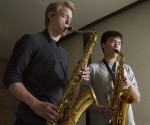Within the UCLA Herb Alpert School of Music, first-year students typically form their own group, second-year students form their own group, and so on. First-year jazz studies student Cody Dear has challenged this dynamic with his latest project, The CD Collective, which mixes ethnomusicology students of different ages with their mutual interests in jazz music.
The Fowler Museum at UCLA will host The CD Collective today for the group’s first performance together, as part of the ongoing Fowler Out Loud concert series. The group will display a musical timeline of jazz, arranged by Dear, containing elements from early jazz to a more contemporary base that is mixed with multiple musical genres such as gospel, R&B; and hip-hop.
“The more that I’ve played jazz music, I’ve realized that since the ’30s and ’40s, what is considered jazz has really changed over time,” Dear said. “I really wanted to capture a timeline to see if I could start from the roots of jazz to where we are at now.”
The musicians of The CD Collective first began collaborating toward the beginning of the school year during a jam session that Dear said aimed to connect incoming first-year students with upperclassmen.
Dear’s arrangement takes into account the musical interests of the others in the group: tenor saxophonist Hugo Shiboski, vibraphonist Grant Milliken, guitarist Chili Corder, bassist Erik Shiboski and drummer Colin McDaniels.
“I thought it would be cool to create this collective group to really show UCLA, and members of the music department who may be coming to the show, a lot of the diversity behind all the students here and what we play,” Dear said.
Corder, a third-year ethnomusicology student and guitarist of The CD Collective, said he feels a strong musical connection with the younger members of the group.
“I don’t feel more experienced than the other members,” Corder said. “I’ve been playing with these people outside of UCLA for a long time so there isn’t too much of a disconnect.”
A major aspect of jazz is its capacity for improvisation, which first-year jazz studies student and tenor saxophonist Hugo Shiboski said serves as an act of communication within the group once one has developed an ear for the music.
“There’s definitively going to be large emphasis on improvisation,” Hugo Shiboski said. “The format of each tune is going to be a typical jazz melody, and then we break out into solos, and members on each instrument will improvise while the band supports them and interacts with the audience.”
Hugo Shiboski will perform alongside his brother Eric, a third-year jazz studies student and bassist of The CD Collective.
“Now that we are in college and there is less of what’s considered an ‘age gap,’ we definitively get a lot more time to play together and play performances,” Hugo Shiboski said. “Sometimes we’ll just meet up and work things out musically. I’m excited to play with him.”
Dear said a sense of activeness in jazz music is what contributed to it originally being used as dance music and as a form of expression.
“You’ll often see musicians closing their eyes or rocking back and forth,” Dear said. “It’s just kind of a form of expression.”
Dear said today’s performance is not solely for the musicians, but is more for the group members to have a form of conversation with the audience and one other.
“You are going to be seeing emotion going on, a lot of interaction,” Dear said. “Probably some cliché little grins coming out of us from something we dig, but with that, it’s still a communication with the audience.”
The smallest variation in an assortment of notes can create a completely different feeling and color for Hugo Shiboski, who said he loves to feel the music while playing tenor saxophone.
“I think the sax can really attain a very dynamic range of timbres and sounds,” Hugo Shiboski said. “I can almost whisper on the instrument and play extremely high and low, so there’s just a lot of freedom that allows me to vocalize my thoughts.”
Dear said he thinks it’s important to add jazz elements to different genres of music because it adds a very unique sensation.
“It really comes down to understanding the music,” Dear said. “I feel like every genre is almost its own dialect and just like learning a new language. Once you learn about the vocabulary and everything, and different harmonic changes and rhythmic changes, you can get to a point where you can experience the music on a new level.”
The musical timeline of the performance will feature influences upon The CD Collective ranging from 1920s George Gershwin standards through the stages of beep-bop, and eventually into the modern age. Hugo Shiboski said that contemporary jazz can be a lot more complex, harmonically and rhythmically, and builds upon traditions of the past.
“We have to really respect the older stuff and the fathers that came before us,” Hugo Shiboski said. “There wouldn’t be contemporary jazz without its precursors and their work is what we need to study in order to move to the modern stuff.”
